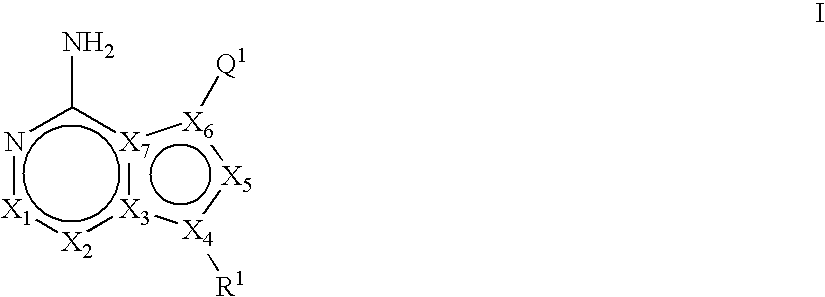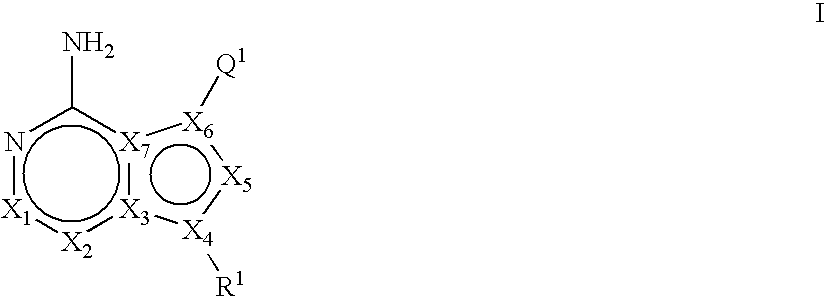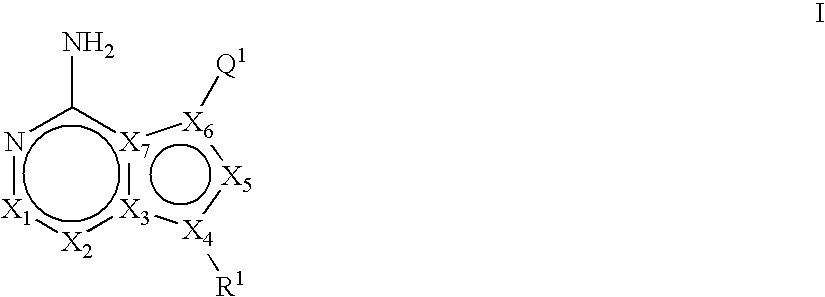6,6-Bicyclic ring substituted heterobicyclic protein kinase inhibitors
a technology of heterobicyclic protein and ring, which is applied in the field of new heterobicyclic compounds, can solve the problems of not being effective against all mutant isoforms of kit kinas
- Summary
- Abstract
- Description
- Claims
- Application Information
AI Technical Summary
Benefits of technology
Problems solved by technology
Method used
Image
Examples
example 1
3-Cyclobutyl-1-(2-phenylquinolin-7-yl)-2H-imidazo[1,5-a]pyrazin-8-ylamine
[0961]
[0962] Gaseous NH3 is condensed into a cooled (dry ice / acetone) solution of 7-(8-chloro-3-cyclobutylimidazo[1,5-a]pyrazin-1-yl)-quinoline (160.0 mg, 0.389 mmol) in 2M NH3 / iPrOH (4 mL) in a pressure tube until the volume is doubled, then the tube is sealed and heated to 110° C. (bath temp.) for 15 h. The solvents are evaporated, and the crude material is chromatographed on silica gel [Jones Flashmaster, 10 g / 70 mL cartridge, eluting with CH2Cl2 (1-7)→1% MeOH in CH2Cl2 (8-23)→2% MEOH in CH2Cl2 (24-46)] to obtain the title compound as yellow solid; 1H NMR (CDCl3, 400 MHz) δ 2.01-2.12 (m, 1H), 2.13-2.27 (m, 1H), 2.47-2.58 (m, 2H), 2.62-2.73 (m, 2H), 3.85 (quint, J=8.0 Hz, 1H), 6.00 (brs, 2H), 7.04 (d, J=5.4 Hz, 1H), 7.15 (d, J=5.4 Hz, 1H), 7.46-7.51 (m, 1H), 7.52-7.58 (m, 2H), 7.91 (dd, J=1.6, 8.4 Hz, 1H), 7.94 (d, J=8.4 Hz, 1H), 7.97 (d, J=8.0 Hz, 1H), 8.18-8.22 (m, 2H), 8.28 (d, J=8.4 Hz, 1H), 8.42 (d, J=0...
example 2
trans-4-[4-Amino-1-(2-phenylquinolin-7-yl)-imidazo[1,5-a]pyrazin-3-yl]-cyclohexanecarboxylic acid amide
[0982]
[0983] An isopropanol solution (20 mL) of trans-4-[4-chloro-1-(2-phenylquinolin-7-yl)-imidazo[1,5-a]pyrazin-3-yl]-cyclohexanecarboxylic acid methyl ester (2.0 g, 4.0 mmol) in a sealed tube was cooled to −78° C. Ammonia was bubbled into the solution for 5 min; the tube was capped and heated to 110° C. for 1 d. The reaction mixture was concentrated in vacuo and partitioned b / w CHCl3 and water. The aqueous layer was extracted with CHCl3 (5×) and the combined organic layers were dried over Na2SO4, filtered, charged with silica gel, and concentrated to yellow solids. The crude material was purified by silica gel column chromatography [Jones Flashmaster, 20 g / 70 mL cartridge, eluting with 5% ˜7 NNH3 in MeOH, 5% MeOH / CHCl3]. The purified material was recrystallized from MeOH / CHCl3 / diethyl ether to afford the desired product as a light yellow solid; 1H NMR (DMSO-d6, 400MHz) δ 1.56-1...
example 3
trans-4-[4-Amino-1-(2-phenylquinolin-7-yl)-imidazo[1,5-a]pyrazin-3-yl]-cyclohexanecarboxylic acid methyl ester
[0988]
[0989] An isopropanol solution (20 mL) of trans-4-[4-chloro-1-(2-phenylquinolin-7-yl)-imidazo[1,5-a]pyrazin-3-yl]-cyclohexanecarboxylic acid methyl ester (2.0 g, 4.0 mmol) in a sealed tube was cooled to −78° C. Ammonia was bubbled into the solution for 5 min; the tube was capped and heated to 110° C. for 1 d. The reaction mixture was concentrated in vacuo and partitioned between CHCl3 and water. The aqueous layer was extracted with CHCl3 (5×) and the combined organic layers were dried over Na2SO4, filtered, charged with silica gel, and concentrated to yellow solids. The crude material was purified by silica gel column chromatography [Jones Flashmaster, 20 g / 70 mL cartridge, eluting with 2% ˜7 NNH3 in MeOH / CH2Cl2] to afford the desired product as a yellow solid; 1H NMR (CDCl3, 400MHz) δ 1.62-1.73 (m, 2H), 1.92-2.02 (m, 2H), 2.15-2.27 (m, 4H), 2.44-2.60 (m, 1H), 2.99-3....
PUM
 Login to View More
Login to View More Abstract
Description
Claims
Application Information
 Login to View More
Login to View More - R&D
- Intellectual Property
- Life Sciences
- Materials
- Tech Scout
- Unparalleled Data Quality
- Higher Quality Content
- 60% Fewer Hallucinations
Browse by: Latest US Patents, China's latest patents, Technical Efficacy Thesaurus, Application Domain, Technology Topic, Popular Technical Reports.
© 2025 PatSnap. All rights reserved.Legal|Privacy policy|Modern Slavery Act Transparency Statement|Sitemap|About US| Contact US: help@patsnap.com



